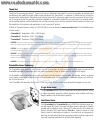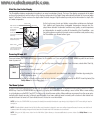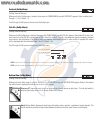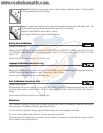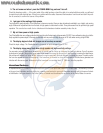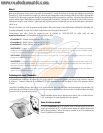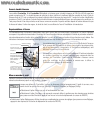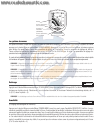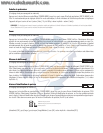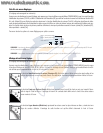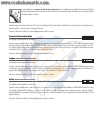
If your boat remains in the water for long periods of time, marine growth can reduce the effectiveness of the transducer. Periodically
clean the face of the transducer with liquid detergent.
If your boat remains out of the water for a long period of time, it may take some time to wet the transducer when returned to the water.
Small air bubbles can cling to the surface of the transducer and interfere with proper operation. These bubbles dissipate with time,
or you can wipe the face of the transducer with your fingers after the transducer is in the water.
Never leave the unit in a closed car or trunk—the extremely high temperatures generated in hot weather can damage the electron-
ics.
Troubleshooting
Do not attempt to repair the PiranhaMax yourself. There are no user-serviceable parts inside, and special tools and techniques are
required for assembly to ensure the waterproof integrity of the housing. Repairs should be performed only by authorized Humminbird
technicians.
Many requests for repair received by Humminbird involve units that do not actually need repair. These units are returned “no prob-
lem found.” If you have a problem with your PiranhaMax, use the following troubleshooting guide before calling the Customer
Resource Center or sending your unit in for repair.
1. Nothing happens when I turn the unit on.
Check the power cable connection at both ends. Be sure the cable is connected correctly to a reliable power source — red lead to
positive, black lead to negative or ground. Ensure the power available is between 10 and 20 VDC. If the unit is wired through a fuse
panel, ensure the panel is powered. Often accessory fuse panels are controlled by a separate switch or the ignition switch.
Also, often a fuse can appear to be good when it is not. Check the fuse with a tester or replace it with a fuse known to be good.
Check the power connection to the PiranhaMax. It is possible to force the power cable connector into the cable holder incorrectly. If
the connector is reversed, the unit will not work. Examine the contacts on the back of the unit to ensure there is no corrosion.
2. There is no transducer detected.
The PiranhaMax has the ability to detect and identify that a transducer is connected. When powering on, if a message indicates
“transducer not connected”, make sure that an appropriate transducer connector is plugged into the unit. In addition, inspect the
transducer cable from end to end for breaks, kinks, or cuts in the outer casing of the cable. Also make sure that the transducer is
fully submerged in water. If the transducer is connected to the unit through a switch, temporarily connect it directly to the unit and
try again. If none of these actions identifies an obvious problem, the transducer itself is probably at fault. Be sure to include the transduc-
er if returning the unit for repair.
3. There is no bottom reading visible on the display.
If the loss of bottom information occurs only at high boat speeds, the transducer needs adjusting – see your Piranha Installation
Guide for details. Also, in very deep water, it may be necessary to increase the sensitivity setting manually to maintain a graphic
depiction of the bottom. If you are using a transducer switch to connect two transducers to the PiranhaMax, make sure that the switch
is in the correct position to connect a transducer that is in the water. (If a trolling motor transducer is selected and the trolling motor
is out of the water, no sonar information appears.) If none of these actions solves the problem, inspect the transducer cable from end
to end for breaks, kinks, or cuts in the outer casing of the cable. If the transducer is connected to the unit through a switch, tem-
porarily connect it directly to the unit and try again. If none of these actions identifies an obvious problem, the transducer itself may
be at fault. Be sure to include the transducer if returning the unit for repair.
4. When in very shallow water, I get gaps in the bottom reading and inconsistent digital depth indication.
The PiranhaMax will work reliably in water 3 feet (0.9 meter) or deeper. Remember that the depth is measured from the transducer,
not from the surface of the water.



